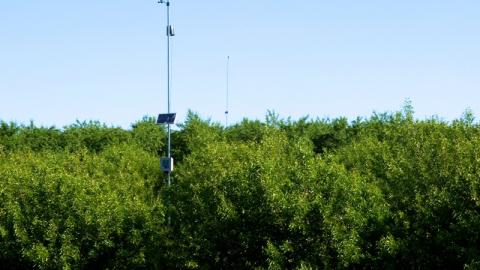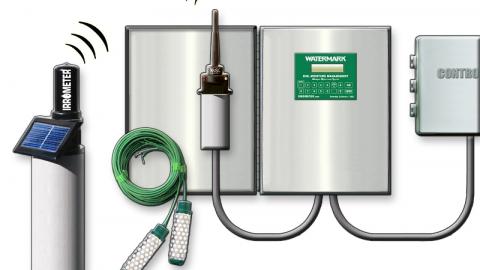The scorching summer that Europe has just experienced has highlighted the importance of irrigation. The fact is that lack of irrigation unfortunately and very often has immediate and harmful effects on production. The catastrophic 2003 summer crop yields prove it! But on the other hand, too much water can result in negative results in terms of production quality. That is why more precise irrigation operation is now a necessity. Certain techniques of irrigation management are based on practices carried out in the field. Tensiometric probes are one of these techniques. They are simple and inexpensive devices that indicate the excess or lack of water in the soil. They can also save water while limiting risks to crops.

What is a tensiometric probe?
A tensiometric probe consists of a sensor which measures the availability of water in the soil using a value named TENSION measured in centibar (cbar).
This measurement indicates the force with which the the water is retained in the soil.
The drier the soil, the higher the tension. The evolution of the values allows the start-up of irrigation and monitors its efficiency.
There are various types of tensiometric probes. They can either be the Watermark type or water-filled tensiometers.
• Watermark probes resist freezing and can remain in position all year long. They are well adapted to permanent crops and provide a range of values from 0 to 200 cbar. The measurements are made with a control panel using as many sensors as desired. The unit is connected to 2 electrical wires with small clips. The Watermark probes consist of a sensor with 2 electrodes encapsulated in sand and connected to 2 electrical wires. The sensor mounted on a PVC tube is pushed into the soil at the desired depth. It is important to make sure that there is proper contact between the sensor and the soil. After a certain time period, a hydric balance between the soil and the interior of the sensor is established. Completely equipped sensors ready for immediate use are now available. Just remove the sheath which maintains the humidity around the sensor.
• The second tyoe of probes are water-filled tensiometers with a calibrated gauge . This is the only type that is reliable for tension under 10 cbar. It is ideal for indicating excessive water that leads to asphyxiation. Its reaction is very rapid. However, its measurement capacity is limited to 80 cbar. It is particularly well suited for vegetable crops. It is an autonomous device with direct readings on a gauge, but the gauge can become inaccurate. It is indispensable to calibrate the gauge each year. It fails easily and therefore requires a constraining follow-up.
How to install them?
The measurement is made in a very small area. It is a narrow sample. The choice of the location is of the utmost importance. It depends on the soil type (select locations which are the most typical of the entire field), the field topography (avoid the lowest elevation areas and mound tops), the crop (avoid scantily planted areas), and the type of vegetation.
Even when chosen with care, the choice does not totally rule out invisible heterogeneity. At what depth(s) should the probes be installed?
The probe must be placed in an area where the moisture varies depending on consumption and water applications. This means that it should be in a root zone covered by an irrigation system. The depth depends on the soil type and
the crop to be irrigated. Measurements made at two depths make it easier to monitor water movement in the soil.
Never forget that the use of tensiometers must be a decision guiding tool and not just extra work.
How are the measurements interpreted?
It is the tension variability, rather than the values, that must be interpreted. It is therefore essential to record the readings obtained. Make at least 2 readings per week, preferably in the early morning, and record them. Plot the readings on a graph or chart either manually or with a computer. The tension evolution can then be visualised. At the same depth: if there are 2 measurement locations, use the average reading if the values are similar. If there is a high variation in the readings, there is a problem. If there are 3 measurement sites, use the middle value. Repeat the procedure for all depths. Plants can easily use soil water up to rather high tension levels which exceed the measurement capacity of the devices. However, there are technical limitations related to the devices which make it advisable to note interpretations of some readings.
From 0 to 10 cbar: The soil contains too much water. This indicates a suffocating plant environment with inadequate root aeration which is unfavorable for the root development of most cultivated crops.
From 10 to 30 cbar: The soil is moist and well soaked. Water is very available. It is ideal for the roots.
From 30 to 120 cbar: The soil is gradually drying out. Water is less and less available.
From 120 to 200 cbar: The water reserve at the measured depth has reached a critical depletion level. Furthermore, a break in the capillary link between the probe and the soil may occur and make it difficult to re-moisten the probe.
Important: these are only general guidelines. They must be modified based on the site soil type (texture, structure).
There now exist meters that record data at a desired frequency. They allow a more precise interpretation of tension evolution and are very useful in low volume irrigation (very frequent irrigations).
How should they be operated?
The installation of measurement sites depends on the type of crop and the type of irrigation used. In all cases, the first thing to do is to make sure that the irrigation system is in proper working order (check the emitters and their flow, and check for proper water distribution if a sprinkler
irrigation system is used).
• Low volume (drip) irrigation: water is applied at certain points. It is diffused into the soil and forms a volume of moisture called a “bulb” if the emitters are widely spaced such as in fruit tree irrigation. On the other hand, the closely spaced emitters in vegetable crops create a more or less continuous strip of moisture.
The shape of the bulb or the strip varies considerably because it depends on the soil structure. The flow must be sufficient to nourish the plant. During watering, three zones can be defined: the central zone is very wet, and often saturated. The outer zone is not affected by the emitter. It is moist at the start of the season, but gradually dries out as the crop water requirements increase. Irrigation will not replenish it. Finally, there is an intermediary zone where tension fluctuations are significant. This is where the probes should be installed.
For vegetable crops, the tensiometric probes are usually installed between two emitters at a distance of 25 cm beyond the lateral and at a depth of 25 cm.
For fruit trees, the probes are installed at a depth of 30 cm at a distance of 30 cm from the emitter between the tree and the emitter. The objective is to maintain a constant volume at the bulb or the strip. The tensiometric control consists of affecting the application and frequency of irrigations to maintain an almost constant tension at the contour of the bulb.
Irrigation start-up is a decisive moment. The applications must be carried out before the soil dries out, i.e. early in the season. An initial water appication will be executed as soon as the tension exceeds 30-40 cbar in vegetable crops or 60-70 cbar in fruit trees. Following that, the application will be gradually increased. During the season, the tension value will be maintained beween 30 and 40 cbar for vegetables and 30-50 cbar for trees.
If the tension increases, it means that the irrigation is insufficient. If
the tension drops significantly, it means that there is too much irrigation. In sandy soil, the applications can be split up rather than increasing the application to the point of overwatering.
• Sprinkler irrigation. The entire soil surface is watered.The soil is
considered as a reservoir. When you irrigate, all of the soil is moistened at various levels: a moisture front percolates towards the bottom. The crop is then allowed to consume part of the reserve. An additional water application can then be stored without risking water loss at the deepest points.
The management principle is to not repeat an application until the previous application has been consumed. A so-called surface probe will be located at a certain depth in the maximum root zone area (30-40 cm for fruit trees, 15 cm for vegetable crops with weak root development, 30 cm for vegetable crops with deeper roots). It can be used for management purposes at the start of the season. A deeper probe is used to monitor excess water or losses due to drainage. It can also be used for irrigation scheduling if the surface probe reacts too quickly. At the end of the season, it can be used to check if the reserves at the depths have been properly exploited. The tensiometers are arrayed in a line near the sprinkler line at a distance of 5-6m from a sprinkler.
To ensure the proper location in a vegetable crop, it is best to carry out an irrigation at the beginning to thoroughly mosten the soil but without water-logging. After that, the roots will develop. Then make sure to monitor the tension evolution at the root level.
The required frequency will be indicated by the evolution of the tensiometric values for all crops. Make sure to allow the values to increase before starting another irrigation.
These small devices can therefore easily show an excess or lack of water. They reassure farmers in their habitual practices or allow them to make changes if necessary. Furthermore, they are an objective reference for irrigation practices within the framework of a list of specifications.



